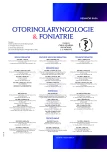Video Head Impulse Test, závrať, vestibulární neuronitida, vestibulární vyšetření, učební křivka
Authors:
J. Loudová 1; J. Holá 2; V. Karvay 3; J. Vodička 1,2
Authors‘ workplace:
Klinika otorinolaryngologie a chirurgie hlavy a krku, Nemocnice Pardubického kraje, a. s., Pardubická nemocnice, Pardubice
1; Fakulta zdravotnických studií, Univerzita Pardubice
2; Klinika otorinolaryngologie a chirurgie hlavy a krku, Fakultní nemocnice U svaté Anny, Brno
3
Published in:
Otorinolaryngol Foniatr, 68, 2019, No. 4, pp. 188-193.
Category:
Original Article
Overview
Objective: Aim of this study was to define learning curve and to analyse the results of video head impulse test (vHIT) in patients with different etiology of vertigo.
Material and methods: We analyzed results of horizontal vHIT in patients with vertigo examined in period from June 2017 to May 2018. In addition to vHIT we recorded the subjective complaints of patients and results of ENT and other examinations. We sorted out records of vHIT according to quality into three groups: good records, records with artefacts and not-evaluable records. Based on quality of vHIT we defined a learning curve. Further, we analysed numbers of pathological vHIT records and gain in different diagnoses of vertigo. To evaluate results, we applied descriptive statistics, chi-square test, t-test and the test of difference.
Results: We defined our learning curve. There were no not-evaluable records after 80 vHIT examinations. Number of pathological vHIT records was significantly higher in group of patients suffering from vestibular neuritis than in Ménière’s disease and BPPV. Patients with vestibular neuritis in acute stage had more often pathological records on vHIT than patients with vestibular neuritis, who were examined after acute stage of the disease. This difference was not significant (p=0.435). There was significant difference between gain on healthy and diseased side in vestibular neuritis (p<0.01).
Conclusion: There were no not-evaluable records of vHIT after 80 examinations on our learning curve. There were significantly more pathological vHIT records in patients with vestibular neuritis than in patients suffering from Ménièr’s disease or BPPV. There was significantly lower gain on diseased side than on healthy side in patients with vestibular neuritis.
Keywords:
Vertigo – Video Head Impulse Test – vestibular Neuritis – vestibular examination – learning curve
Sources
1. Blödow, A., Heinze, M., Bloching, M. B. et al.: Caloric stimulation and Video Head Impulse Testing in Menière’s disease and vestibular migraine. Acta Otolaryngol, 134, 2014, 18, s. 1239-1244.
2. Blödow, A., Pannasch, S., Walther, L. E.: Detection of isolated covert saccades with the Video Head Impulse Test in peripheral vestibular disorders. Auris Nasus Larynx, 40, 2013, 4, s. 348-351.
3. Černý, R., Čakrt, O., Jeřábek, J.: Laboratorní metody vyšetření vestibulárního aparátu. Neurol prax, 18, 2017, 3, s. 163-169.
4. Guan, Q., Zhang, L., Hong, W. et al.: Video Head Impulse Test for evaluation of vestibular function in patients with vestibular neuritis and benign paroxismal positional vertigo. Zheijang Da Xue Xue Bao Yi Xue Ban, 46, 2017, 1, s. 52-58.
5. Halmagyi, G. M., Curthoys, I. S.: A clinical sign of canal paresis. Arch Neurol, 45, 1988, 7, s. 737-739.
6. Halmagyi, G. M., Chen, L., MacDougall, H. G. et al.: The Video Head Impulse Test. Front Neurol, 8, 2017, 258, s. 1-23.
7. Chen, T. S., Li, S. S., Dong, H. et al.: Analysis of the dysfunction frequency and characteristics of semicircular canal in benign paroxysmal positional vertigo. Zhonghua Er Bi Yan Hou Tou Jing Wai Ke Za Zhi, 47, 2012, 10, s. 793-798.
8. Jeřábek, J.: Diagnostika pacienta s akutní závratí. Cesk Slov Neurol, 78/111, 2015, 5, s. 503–510.
9. Kattah, J. C., Talkad, A. V., Wang, D. Z. et al.: HINTS to diagnose stroke in acute vestibular syndrome – three-step bedside oculomotor examination more senzitive than early MRI diffusion-weighted imaging. Stroke, 40, 2009, 11, s. 3504-3510.
10. Lin, Y., Gao, l., Han, L. et al.: Video Head Impulse Test in peripheral vestibular diseases. Zhonghua Er Bi Yan Tou Jing Wai Ke Za Zhi, 50, 2015, 9, s. 724-728.
11. Mantokoudis, G., Teherani, A. S. S., Wozniak, A. et al.: VOR gain by Head Impulse Video-oculography differentiates acute vestibular neuritis from stroke. Otol Neurotol, 36, 2015, 3, s. 457-465.
12. McGarvie, L. A., Curthoys, I. S., MacDougall, H. G. et al.: What does the dissociation between the results of video head impulse versus caloric testing reveal about vestibular dysfunction in Menière’s disease? Acta Otolaryngol, 135, 2015, 9, s. 859-865.
13. Newman-Toker, D. E., Tehrani, A. S. S., Mantokoudis, G. et al.: Quantitative video-oculography to help diagnose stroke in acute vertigo and dizziness. Stroke, 44, 2013, 4, s. 1158-1161.
14. Walther, L. E.: Current diagnostic procedures for diagnosing vertigo and dizziness. GMS Curr Top Otorhinolaryngol Head Neck Surg, 16, 2017, Dostupné z URL: https://www.egms.de/static/en/journals/cto/2017-16/cto000141.shtml
15. Welgampola, M. S., Akdal, G., Halmagyi, G. M.: Neurootology – some recent clinical advances. J Neurol, 264, 2017, 1, s. 188-203.
16. Yang, C. J., Cha, E. H., Park, J. W. et al.: Diagnostic value of gains and corrective saccades in Video Head Impulse Test in vestibular neuritis. Otolaryngol Head Neck Surg, 159, 2018, 2, s. 347-353.
Labels
Audiology Paediatric ENT ENT (Otorhinolaryngology)Article was published in
Otorhinolaryngology and Phoniatrics

2019 Issue 4
Most read in this issue
- Video Head Impulse Test, závrať, vestibulární neuronitida, vestibulární vyšetření, učební křivka
- Bilateral Peritonsillar Abscess
- Primary Vasculitis in Otorhinolaryngology: Review of the Literature and Case Reports
- Balloon Eustachian Tuboplasty in Treatment of Chronic Otitis Media with Effusion
